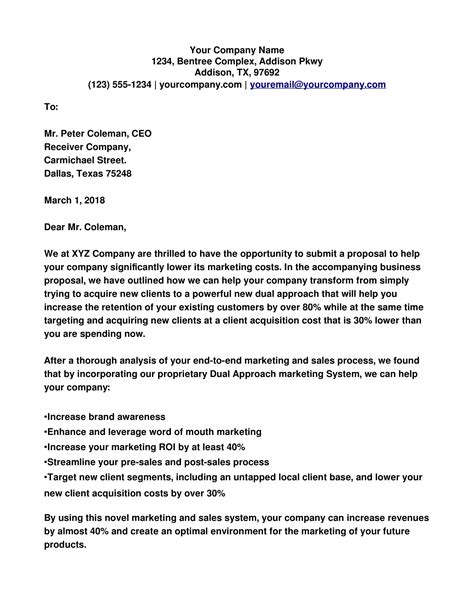Writing A Business Proposal Letter: Examples & Tips

Are you looking to secure a business deal or partnership? One effective way to do so is by writing a compelling business proposal letter. A well-written proposal letter can help you make a strong impression on potential clients or investors and increase your chances of success.
1. Understand the Purpose of the Proposal Letter
Before you start writing your business proposal letter, it’s important to understand its purpose. The main goal of a proposal letter is to convince the recipient to take a specific action, such as accepting your business proposal, investing in your company, or entering into a partnership.
Example:
Dear [Client/Investor/Partner’s Name],
I am writing to propose a strategic partnership between our companies that will allow us to leverage our respective strengths and achieve mutual growth and success. We believe that by combining our expertise and resources, we can create a powerful synergy that will benefit both of our organizations.
2. Research and Gather Relevant Information
Before you start drafting your proposal letter, it’s crucial to conduct thorough research and gather all the necessary information. This includes understanding the needs and preferences of the recipient, as well as any specific requirements or guidelines they may have provided.
Tips:
- Research the recipient’s company or organization to understand their goals, values, and current projects.
- Gather data and statistics that support your proposal and demonstrate the potential benefits.
- Obtain any necessary documents or supporting materials that may be required.
3. Structure Your Proposal Letter
A well-structured proposal letter is more likely to be read and considered. Use clear headings and subheadings to organize your content and make it easy for the recipient to navigate. Here is a suggested structure for your business proposal letter:
- Introduction: Start with a brief introduction that captures the reader’s attention and provides an overview of your proposal.
- Background: Provide background information about your company, its history, and any relevant accomplishments.
- Problem Statement: Clearly outline the problem or challenge that your proposal aims to address.
- Solution: Present your proposed solution or idea, highlighting its benefits and how it addresses the problem.
- Implementation Plan: Outline the steps and timeline for implementing your proposal.
- Cost and Budget: Provide a detailed breakdown of the costs involved and any financial projections.
- Benefits and ROI: Explain the potential benefits and return on investment for the recipient.
- Conclusion: Summarize your proposal and reiterate the key points.
- Next Steps: Clearly state the desired action or response you expect from the recipient.
- Closing: End the letter with a polite and professional closing.
4. Use Persuasive and Professional Language
When writing your proposal letter, it’s important to use persuasive and professional language that conveys your confidence and credibility. Use strong and clear language to articulate your ideas and avoid any jargon or technical terms that may confuse the reader.
Tips:
- Keep your sentences concise and to the point.
- Use active voice to make your writing more engaging.
- Highlight the unique selling points of your proposal.
- Address any potential concerns or objections the recipient may have.
- Proofread your letter for grammar and spelling errors.
5. Customize and Personalize Your Proposal
A generic proposal letter is unlikely to make a strong impact. Take the time to customize and personalize your letter to the specific recipient. Address the recipient by name and tailor your content to their needs and preferences.
Example:
Dear [Client/Investor/Partner’s Name],
As a long-time admirer of [Recipient’s Company/Organization], I am thrilled to have the opportunity to present a unique business proposal that aligns perfectly with your organization’s mission and vision. Our team has carefully analyzed your recent projects and identified a potential area of collaboration that we believe will deliver exceptional results.
6. Include Supporting Documents and References
To strengthen your proposal and provide additional credibility, consider including supporting documents and references. These can include case studies, testimonials, industry reports, or any other relevant materials that support your proposal.
Tips:
- Include links or attachments to relevant documents.
- Cite credible sources to back up your claims or statistics.
- Highlight any previous successful collaborations or projects.
- Include contact information for references if applicable.
7. Proofread and Edit Your Proposal Letter
Before sending out your proposal letter, make sure to thoroughly proofread and edit it for any errors or inconsistencies. A well-written and error-free letter will enhance your professionalism and attention to detail.
Tips:
- Read your letter aloud to catch any grammatical or structural issues.
- Check for spelling mistakes or typos.
- Ensure that your formatting is consistent and easy to read.
- Ask a colleague or friend to review your letter for feedback.
Conclusion
Writing a business proposal letter can be a challenging task, but with careful research, planning, and attention to detail, you can create a compelling letter that increases your chances of success. Remember to customize your letter to the specific recipient and use persuasive language to convey the value and benefits of your proposal.
Frequently Asked Questions
- What is the purpose of a business proposal letter?
- How should I structure my proposal letter?
- What language should I use in my proposal letter?
- How can I personalize my proposal letter?
- Should I include supporting documents with my proposal?
- How important is proofreading and editing my proposal letter?
